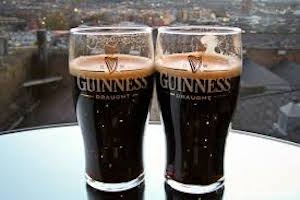 Today, St Patrick’s Day will see many a Guinness poured around the world. Synonymous with Irish culture, Guinness lovers claim it to be the elixir of health and good fortune, while others bravely wade through one on March 17th for the sake of tradition.
Today, St Patrick’s Day will see many a Guinness poured around the world. Synonymous with Irish culture, Guinness lovers claim it to be the elixir of health and good fortune, while others bravely wade through one on March 17th for the sake of tradition.
On the last day of 1759, a young lad named Arthur Guinness signed a lease on the property for 9,000 years at £45 per annum in Dublin’s St James St. The Street was already home to several other small breweries, all attracted to this spot by a good supply of water. At that time, beer was almost unknown in rural Ireland where whisky, gin and poteen were the alcoholic drinks most readily available.
In addition to ales, Arthur Guinness brewed a beer relatively new to Ireland that contained roasted barley which gave it a characteristically dark colour. ‘Porter’ as it was known had been developed England several years earlier and became known as such because of its popularity with the porters and stevedores in London. However, young Arthur Guinness brewed porter so well that he eventually ousted all imports from the Irish market, captured a share of the English trade and revolutionised the brewing industry.
The word Stout was added in the early 1820’s as an adjective, an “extra stout porter” was a stronger and more full bodied variety. Eventually, the Guinness brewery gave up brewing other ales and concentrated on its signature brew (by 1914 the brewery at St James’ Gate was the largest in the world! Guinness is now brewed in 35 other countries around the world, but all these overseas brews must contain a flavoured extract brewed at St. James’s Gate in Dublin.
Did you know:
- Nearly 40% of Guinness is consumed in Africa – Nigeria consumes the second highest amount of Guinness in the world (after England and before Ireland!)
- In 1954, managing director Hugh Beaver launched a compendium of little-known facts called the Guinness Book of Records. Originally intended as a marketing giveaway, the book became a runaway success
- Guinness is actually a deep, dark red, due in part to the roasting of malted barley during preparation.
- Arthur Guinness funded Ireland’s version of the Red Cross and creating housing developments for Dublin’s poor. As a company, Guinness supported Irish troops in both World Wars, guaranteeing its workers jobs upon return from service and paying their families a portion of their salary in absentia.
- Guinness is rich in iron and antioxidants and relatively low in calories (a 20-ounce pint contains 210 calories).
- Guinness is a pantry staple – use it to tenderise beef in a classic meat-and-potatoes Irish stew, drizzle on vanilla ice cream or add to bread.
- Unlike other taps Guinness is dispensed through a five-hole disk restrictor plate, which supplies an uncommon amount of nitrogen, making the head extra-effervescent. As such, a double pour is needed: one to start the magic, and a second to finish the job. The perfect pint is said to take 119.5 seconds to pour.









Join the Discussion
Type out your comment here:
You must be logged in to post a comment.